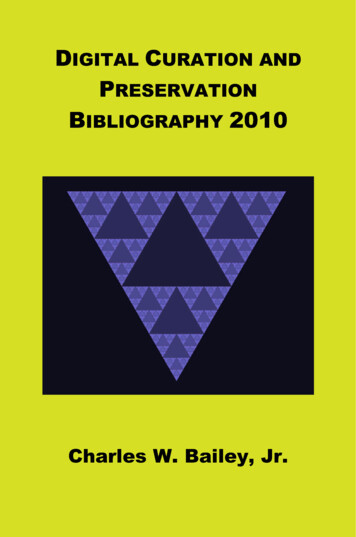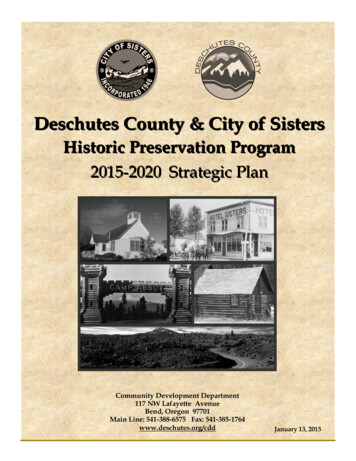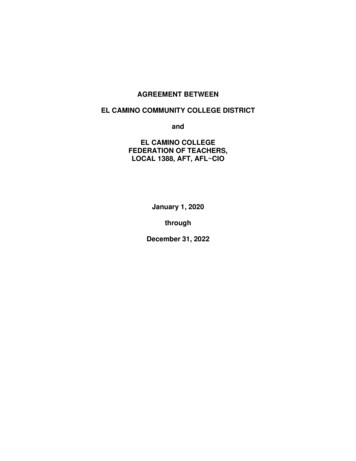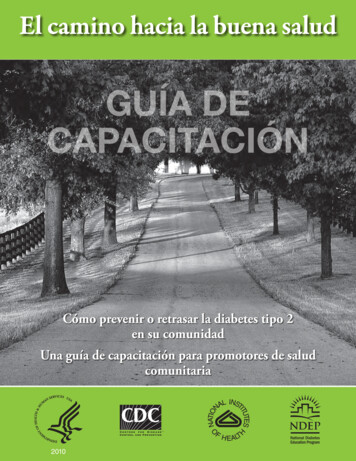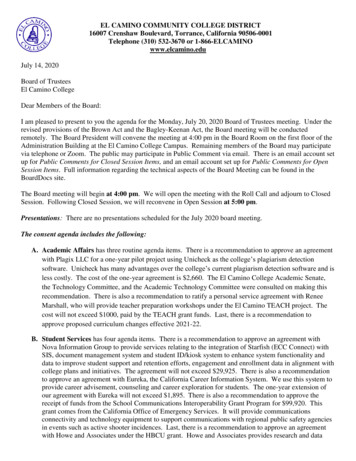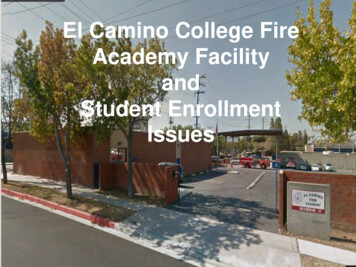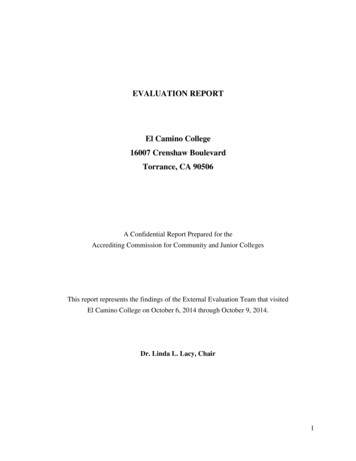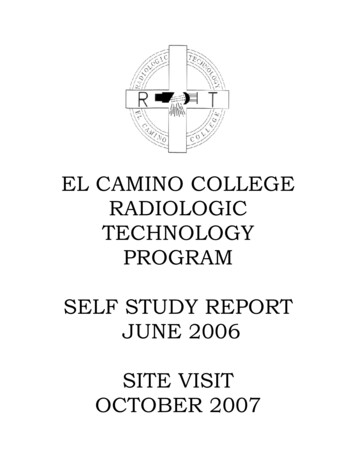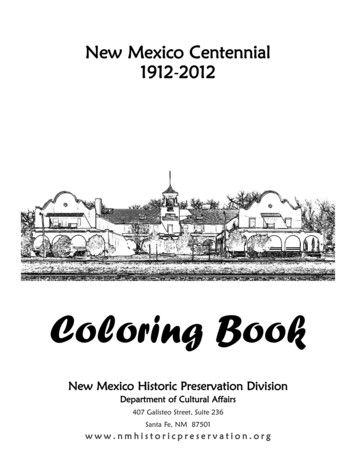
Transcription
PSUMMER 2011Volume 25Number MEXICOPreservationDivisionCamino Real Honored During Preservation Month39th Annual Heritage Preservation Award WinnersPerhaps no road changed the cultural and physical landscape of NewMexico more than the Camino Real.Eleven segments are listed in the StateRegister of Cultural Properties, andnominations for up to 17 more arebeing prepared.HPD chose to honor El CaminoReal de Tierra de Adentro duringHeritage Preservation Month 2011 inlight of concerted efforts to preservethe trail’s 300-year legacy, but also as alook forward to celebrating the StateCentennial in 2012 and the recent designation of the Mexico section of thetrail as a World Heritage Site.When the Spanish codified whatmany believe were Native Americantrade trails into the “Royal Road” linking Mexico City first to San Gabrielde Yuque-Ouinge-and a few yearslater to the permanent northern capital of Santa Fe, they brought changesthat forever transformed the culturaland physical landscape of NewMexico.The State Register listing is underconsideration for the NationalRegister by the National Park Service.The nomination highlights numerousinnovations we take for granted thatfirst appeared in the state via theCamino Real. Architectural influencesthat led to the Spanish-Pueblo Revivalthe nation’s first internationalhighway.“For three centuries, theCamino Real facilitated the interchange of ideas, values and customs that created the social,religious, economic and politicallandscape of the border region,”according to the State Registernomination written by MerlanAssociates, LLC, a consulting andhistorical research firm based inSanta Fe.EventsThe theme and recent effortsto raise awareness of the Caminosparked interest up and down thetrail prompting approximately 35Preservation Month events thatnever had been held before. Inall, there were nearly 70 eventsstatewide during May. TheyDCA Secretary Veronica Gonzales and interim SHPOJan Biella present Acoma Pueblo Preservation Directorincluded archaeological hikes, hisTheresa Pasqual on her award.toric district tours, ceremonies,and Territorial styles, new language,re-enactments and educational sesEuropean agricultural practices andsions that have become Preservationcrops, sheep, cattle and other domestiMonth traditions. In addition, specialcated livestock. New art forms, relitours of the Camino’s infamousgious expression, music, householdJornada del Muerto and New Mexicofurnishings, textiles, clothing, andSpaceport, which is built along thetransportation means that had nevertrail, a documentary film class focusedbeen used in New Mexico firston the road’s legacy, and numerousappeared with settlers who came upother events were staged for the firstsee Preservation Month, page 4
2 0 1 1S u m m e rPreservation New Mexico is published by the NewMexico Historic Preservation Division, Department ofCultural Affairs. Preservation New Mexico is edited,designed and produced by Tom Drake, HPD PublicRelations. Readers are invited to submit information andarticles for publication. This publication also appears onHPD’s website.Send photographs, stories and ideas by e-mail to TomDrake, tom.drake@state.nm.us., 505-827-4067.This publication is financed with federal funds fromthe National Park Service, U.S. Dept.of the Interior andother sources. The contents and opinions do not necessarily reflect the views or policies of the Interior Department.HPD programs receive federal financial assistance foridentification and protection of historic properties. UnderTitle VI of the Civil Rights Act of 1964, Section 504 ofthe Rehabilitation Act of 1973, and the AgeDiscrimination Act of 1975, the Interior Department prohibits discrimination on the basis of race, color, nationalorigin, disability or age in its federally assisted programs. If you believe you have been discriminatedagainst in any program, activity, or facility as describedabove, or if you desire further information, please writeto: Office of Equal Opportunity, National Park Service,1849 C Street, N.W., Washington, D.C. 20240.New Mexico Historic Preservation DivisionBataan Memorial Building407 Galisteo, Suite 236Santa Fe, NM 87501w w w. n m h i s t o r i c p r e s e r v a t i o n . o r gS u m m e r2 0 1 11Heritage Preservation Month2News Briefs—Tax Credits, EndangeredResources, CAMP and more5Window Restoration College6Preservation Award Winners8New in the Registers9VOTE! This Place Matters10NM SiteWatch Involves Youth11 OAS Recovers Prehistoric Bison Remains11 Manhattan Project National Park12 Future of Preservation is Youth12 HPD Internphoto credits (page and photographer):1p.2p.3p.4news briefsPRESERVATIONHISTORIC PRESERVATION DIVISIONPRESERVATION NEW MEXICOVolume 25 Number 3Tom DrakeRobert SelinaHPD file photos: Aztec Motel: Ed BolesCamera: Talease Shipley; Salmon Ruins, DavidRasch; Boy Scouts: Jean Fulton; poster by Tom Drake5 Tom Drake6&7 Tom Drake & Harvey Kaplan8Martinez Interior: Shannon Papin; Mother MaryKatharine: HPD File Photo: CPRC; Tom Drake9Woodall property: HPD file photo; “Mudder’s Day”courtesy Beth O’Leary10 Bob Shiowitz and Norman Nelson11 Robert Dello-Russo; High Bay courtesy LANL12. Tom DrakeTax Credit Success StoriesConstancio Mierra House in San Antonio wasrestored with state tax credits.A 6.9 million adaptive re-use of the19th century Ilfeld Department Storethat nearly doubled the amount of roomsat the Historic Plaza Hotel in Las Vegashas been approved for federal preservation tax credits.Adjacent to the Plaza, the project carefully joined the two buildings with a threestory connector that is not visible fromthe front, which faces the Las VegasPlaza. Opened for business for approximately a year, construction was completedin phases, providing downtown Las Vegasbanquet and meeting hall facilities. Theexpansion was projected to increasetourism and economic development in thecity’s historic core.Owned by Plaza Ilfeld, LLC, 2011Lifetime Achievement winner Wid Slick ismanaging member, the building qualifiedfor 1.4 million in credits that offset federal income taxes for 19 years. The creditsare one of a few bricks-and-mortar incentives available to historic properties owners.El Raton Theater has become acommunity gathering place in downtownRaton. Repairs were in part financed by apreservation loan from HPD and also bystate tax credits approved by the CPRC inJune. A new roof and heating system,electrical work and repairs to two storefronts off of the lobby are eligible forcredits that can be taken against stateincome taxes for five years. The theaterwas completed in an atmospheric Moorisharchitectural style in 1930. The currentowners show via satellite MetropolitanOpera concerts and political events,screen free children’s matinees in summer2and run regular features.Outside of Socorro, the owners of theConstancio Mierra House in SanAntonio have invested into the restorationof a 1907 late Victorian adobe house. Theentire project has been hands-on byRobert and Denise Selina, who began bysuccessfully nominating the historic property to the State Register in 2009. The listing made it eligible for state tax creditsand in June approved by the CPRC a inJune. The Selinas restored the historicwood-framed window themselves byhand— removing, repairing, reassemblingand installing them. The house wasreroofed and chimneys rebuilt to theiroriginal height. The front porch was refurbished, a new electrical system installed,interior woodwork repaired and the exterior restuccoed. San Antonio has long beenknown for the historic Owl Café listed inthe National Register in part for its association with the Manhattan Project. TheSelinas have restored another piece of thesmall town’s history; the home of one itsfirst builders and businessmen.Chaco Landscape EndangeredThe National Trust for HistoricPreservation placed the Chaco culturallandscape on its 11 Most EndangeredHistoric Places List. Hundreds of culturaland arachaeological sites including AztecRuins and Chaco Culture NationalHistoric Park are threatened by oil-andgas development in northwestern NewMexico, the Trust said.“To some extent, Aztec Ruins isendangered by energy development, eventhough we’re a small site,” Tracy Bodnar,chief ranger at Aztec Ruins NationalMonument, told the Daily Times inFarmington.” The architecture also can bedamaged when big trucks go by, with thevibrating effects.”Bodnar said that while three active gaswells are inside the boundaries of AztecRuins, gas companies have cooperatedwith the monument to prevent damage.Bear Butte in South Dakota—sacredto Native Americans—also was named asendangered.
Released June 14, the list also includesjazz great John Coltrane’s House on LongIsland, which has deteriorated due to lackof funds for making it an art-and-education center.The Trust for the first time placed anentire city on its Watch List. It namedCharleston, S.C., as threatened by expanded cruise ship tourism that could harmthe city’s historic character. Residents andenvironmentalists sued Carnival CruiseLines alleging the company’s ships createnoise pollution and congestion in theirpreserved city.One listing is devoted to historic sitesimperiled by state actions as legislaturesnationwide consider preservation fundingcuts. Michigan eliminated historic preservation tax credits, and Texas has considered deep cuts with one proposal to eliminate its state historic preservation agency.The list has identified more than 200threatened one-of-a-kind historic treasuressince 1988. The entire list can be viewedat www.preservationnation.org.Preservation Summer “CAMP”Sessions were held at the Ilfeld Auditorium,listed in the State and National Registers.Local preservation commissioners,planners, architects, lawyers and codeenforcers met with nationally recognizedexperts at a day-and-one-half CAMP session held in Las Vegas this month.The city, one of eight New MexicoCertified Local Governments, hosted theJune 2 and 3 sessions, covering expensesthrough a grant from HPD. The annualCommission Assistance and MentoringProgram, or CAMP, provides interactivetraining for historic preservation commissions with a focus on fundamentals thatevery commission member and localpreservation advocate should know. Thetraining arms commissions with progressive local regulation expertise and outlinesstrategy for the most effective protectionof local historic sites and landmarks.Workshop topics focused on commission training in historic preservation andincluded topics ranging from legal basicsrelated to local ordinances, developmentof preservation plans, standards andguidelines for design review, and publicinvolvement in local preservation activities. Held at New Mexico HighlandsUniversity, attendees, included representatives from the Las Vegas, Santa Fe, SilverCity and Taos CLGs. Architects qualifiedfor 10 Architectural Continuing Educationcredits in health, safety and welfare. Morethan 25 people participated in the training.CAMP “counselors” were JohnWilliams, founding partner of HoshideWilliams Architects from Snohomish,Washington and a member of theAdvisory Council on HistoricPreservation; Dan Becker, ExecutiveDirector of the Raleigh Historic DistrictsCommission; Pratt Cassity, Director ofthe Center for Community Design andPreservation at the University of Georgia;and Ramona Murphy Bartos, an attorneybased in Rincon, Georgia.New Mexico CLGs can apply eachyear for grants to cover related educationcosts for local design review board members and staff.Preservation Advocacy in D.C.For the second year, HPD could notattend the annual NatationalConference of State HistoricPreservation Officers and meet personally with New Mexico’s Congressionaldelegation. So, former SHPO KatherineSlick and Navajo Nation THPO AlanDowner volunteered to take on the task.They lobbied for NPS preservation funding for New Mexico and the nation’sSHPOs. Ms. Slick sent the following summary of their meetings.Armed with an introductory letter fromInterim SHPO Jan Biella, the 2009-2010HPD “Activities Report” and supporting documents from the National Trust for HistoricPreservation, National Park Service andNCSHPO, we met with the delegation and staffto discuss preservation issues and requests. Theagreed-upon-by-all-partners request for 2012 forthe Historic Preservation Fund is 70 million or10% less than the 2008 funding level. We said3that for the second time in our collective memories,the request for funding for SHPOs ( 50 million)and 11 million for THPOs was what theAdministration requested.The 70 million HPF request has 9 million included for Save America’s Treasures andPreserve America in 2012; however, theAdministration has zeroed out funding for thoseprograms. The delegation representatives expressedtheir interest and willingness to continue fundingSAT and PA, recognizing the importance ofgrant monies, especially bricks-and-mortar money,to projects in New Mexico. We stressed theimportance of leveraging federal dollars, taxincentives and the number of jobs created.”Demise of a Route 66 IconDemolition of the Aztec took two weeks in June.It was the oldest continuously operated Route 66 motel in New Mexico andEast Central Avenue’s first auto court.Built in 1933, four years before Route66 was realigned to bypass Santa Fe andcome down Central Avenue throughAlbuquerque, the Aztec Auto Courtsuccumbed in part to a fragile economy.It had structural problems that combined with its small size of 20 guestrooms would have made rehabilitationeconomically unfeasible, according toowner Jerry Landgraf.Listed in the State and National registers in 1993, the building became alocal and mostly beloved icon less for itsmodest use of Southwest VernacularStyle than as a folk art installationbeginning more than a dozen years ago.An Albuquerque Journal article chronicledthe Aztec’s last incarnation beginningwith an empty whiskey bottle left on theproperty and converted into a flowervase. More bottles appeared, more flowers and eventually people dropped offbroken tiles, statuary and found objects,enhancing an earlier attempt to restorethe old auto court’s original landscaping.The neon sign, a replacement of theoriginal is expected to remain as a memory of the motel.
Preservation Monthfrom page 1Documentary filmmaking on the CaminoReal was presented by filmmaker JasonVan Camp and CARTA with funding by theNational Park Service. The late May session was held on the Jornada del Muertoand is one of several held at the end ofeach month through July. Chance Gordonparticipated through a sponsorship by Roband Rhonda Spence, of Hatchtime.The events are a key componentof Preservation Month. They drawpublic participation in the thousands.State and national parks, cities andtowns, organizations and neighborhoods stage the events and HPD publishes them in a Calendar of Events.HPD would like to especiallythank the Camino Real de TierraAdentro Trail Association for itsefforts to infuse many of the newevents into our calendar. At the sametime, New Mexico State Parks, theSalmon Ruins Museum and ResearchCenter, the Folsom Museum,Tinkertown Museum and many othershave sponsored Preservation MonthEvents help raise awareness. Mr. Baker’stour included a look at an entire rock artpanel was removed by thieves.events for many years andtheir continued participationforms part of the backboneof Preservation Month.Boy Scout Troop 85 improvedthe Yost Escarpment trail headon the Camino during a Maycamp out.PosterCorporate SponsorsThe annual poster—the office’s 23rd,featured a mid-1800’s improvement tothe Camino by the military on top ofLa Bajada, approximately 20 milessouth of Santa Fe.Like all roads, the alignment of theCamino changed during its 300 yearsof use and this later cut provided analternative route for wagons and largecargo from an earlier one that followed the Santa Fe River Canyon.The segment is very near the twoalignments of Route 66 that traversedLa Bajada, 600 feet above the RioGrande Valley that were the MotherRoad’s primary route until La Bajadawas bypassed in 1937.Larry Baker, Salmon Ruins Museum director, leads a pictograph tour atDelgadito Canyon as part of the DinetahArchaeological Tour on May 14.Bureau of Land ManagementCamino Real De Tierra Adentro Trail Assoc.National Park ServiceWatson ConservesSponsorsThe poster is free to the public and fundedentirely by sponsorships through an HPDand New Mexico Heritage PreservationAlliance partnership.4Archaeological Society of New MexicoAtkin Olshin Schade Architects; Crocker LTD;El Camino Real International Heritage Ctr;Victoria Jacobson, AIA; Marron and Assoc.,Inc.; MNMF-Friends of Archaeology/Ofc ofArchaeological Studies; Sal Martino; Will B.Murphey; National New Deal PreservationAssoc.; NM SiteWatch; NMDOT; Red BrickBldg Restoration Foundation; Katherine Slick;TRC Environmental Corp; Van Citters HistoricPreservation, LLC; In Memory of Robert J.and Florence M. Victor; XTO Energy, Inc.
Window Restoration CollegePreservation Month —replacement window and usually forless money,” says Yapp. “Original windows define being ‘green’.”Restoring wood-frame windowskeeps them out of landfills, preservesimportant architectural elements ofhistoric homes and buildings, and doesnot require the use of petrochemicalsand nonrenewable resources to manufacture replacement windows. Theproblem, Yapp says, is that there arefewer and fewer people who knowhow to maintain wood-frame windows,which has made their repair for manyan unaffordable specialty.“If we want people to keep woodwindows, we have to train them how tomaintain them,” Yapp said during theWindow Restoration College held at aSecond Empire Victorian-style home.handymen, including two YouthConservationCorps members,enrolled in theworkshop at nocost. The City ofAlbuquerque wasable to sponsorthe training session through aSchool founder Bob Yapp restores a window.Derryk Sena was 14,000 grant itone of two YCCreceived for beingn estimated 16-million woodmembers who reenrolled in theenforced skills heframed, sash windows end up in landCertified Localacquired restoringfills every year. More than six-million ofGovernment prohistoric buildings inthem were made from old-growthBernalillo.gram administeredwood, and in most cases they areby HPD.trashed unnecessarily in the name ofMaryellen Hennessey, preservaenergy efficiency. These are among thetion planner for the city, made herfacts students of the Belvederehistoric home available for theSchool for Hands-Onworkshop after two other resiPreservation learn during windences previously selected felldow restoration bootcamps.through. She contacted workshopBob Yapp, who foundedparticipants by circulating fliersthe school based in Hannibal,through contracting networks.Missouri, in 2008, and has travYapp said her home’s original wineled the country for 20 yearsdows would last another 100 yearsconducting similar workshops,because of how they were restored.debunked what he called “theAll of the workers volunteeredlie” of vinyl windows at a fivetheir time to attend the sessionsday workshop held inand were certified by the schoolAlbuquerque as part ofafter the five-day training, whichThe 108-year-old windows were removed, tracks addedHeritage Preservation Month.and rubber stripping installed that will make them air tight.concluded with a business session.According to Yapp, even anOriginal counterweights were restrung and re-installed inThey can be contacted for windowunrestored, double-hung woodthe original framing.restorations through theframe window with a storm isAlbuquerque Landmarks andmore energy efficient than a vinylHis theory, train more people toUrban Conservation Commission byreplacement window.maintain historic windows so the costreaching Ms. Hennessey.“This madness is unnecessaryof restoring them, which can reach abecause original windows can be madestaggering 800 to 1,200 per window,to be as or more energy efficient than acan be more than cut in half.“If the price is brought down to 400 per window and the owner can getNew Mexico’s 50-percent state historicpreservation income tax credit, then it’scompetitive,” Yapp said referring to thecredit available to properties listed inthe State Register or that contribute toan historic district. With the credit, aBuilt in 1903, the home was surrounded byrestored window could cost an economorchards and market gardens at the edge ofNot only did Ms. Hennessey make her homeical 200 a piece.town. Constructed of adobe, it was a standavailable for the sessions, she provided aout with its shake-shingled, mansard roof.Approximately10contractorsandhome-cooked lunch daily for the participants.A5
A2011 Heritage Preservation Awards Winnersn even dozen Heritage Preservation Awards were presented to 19 individualsand organizations on Friday, May 13.It was the 39th annual awards ceremony, a time when the Cultural PropertiesReview Committee rewards outstanding achievement in the field. The committeeis HPD’s policy and advisory panel. Department of Cultural Affairs SecretaryVeronica Gonzales was master of ceremonies, personally presenting awardssigned by Governor Susana Martinez, CPRC Vice-Chairman and the interim StateHistoric Preservation Officer Jan Biella.Awards this year included important architectural rehabilitations that havemade major changes in their communities. The CPRC also recognized outstanding efforts to preserve other elements of New Mexico history, including language,the growth of medicine, El Camino Real and downtown areas statewide.HPD hosts the ceremony, pulling out all the stops to make the occasion memorable for award winners. Held in the auditorium of the historic Scottish RiteCenter, it opened with Chris Abeyta’s Spanish guitar music followed by award presentations by CPRC members and closedwith “Las Mañanitas.” The center has donated the building for eight years for the awards in part because it believes stronglyin preserving architectural and cultural heritage. A reception catered entirely by staff with refreshments followed, along withadditional congratulations in the courtyard and dining hall of the 1912 Moorish-style temple.Lifetime AchievementH OTEL P ARQ C E N T R A L —For the adaptive re-use ofthe Santa Fe Hospital forAT&SF Railway Workers inAlbuquerque by DavidOberstein, Marc Bertram,Marquita Russel andElizabeth Cavasos. A crowning achievement in theHuning Highlands Historic District, the hotel’s Apothecary Lounge, itswide hospital hallways, windows rooms and other features conform tothe hospitals’ original design.W I L L I A M “W I D ” S L I C K — For 30 yearsdedicated to preserving, investing andbelieving in some of the City of Las Vegas’smost significant historic architecture.Beginning with the Plaza Hotel in1982—built in 1882, it is a cornerstone intown—Mr. Slick has been involved in morethan 16 rehabilitations. He recently completed an adaptive re-use of the historic IlfeldBuilding adjacent to the Plaza. Wid sayswhat he is most proud of is being part of alarger effort to preserve so many buildingsdowntown.MIMBRES VALLEY BREWING COMPANY —For Bryan Reedy’s adaptive re-use of historic 200 South Gold Avenue in Deminginto a microbrewery and restaurant. Mr.Reedy overcame financial challenges in asmall town where downtown revitalizationcan be challenging. The converted 1886stables and meat market opened a yearago and is drawing visitors and localsdowntown.Architectural HeritageHOTEL ANDALUZ — For Goodman RealtyGroup’s rehabilitation of Albuquerque’s historic Hilton Hotel and re-opening it as theHotel Andaluz. The hotel’s lobby, restaurantand lounge are again an Albuquerque destination and its presence is changing thedynamics of downtown. One of ConradHilton’s first hotels, U.S. Senator John F.Kennedy, President Lyndon B. Johnson andactress Zsa Zsa Gabor stayed there, she asHilton’s bride. Darin Sand accepted theaward on behalf of the hotel and worked closely with HPD using federal rehabilitation income-tax credits that were part of a complexfinancial package. The building is one of only two U.S. historic hotels tobe certified at the Gold level by LEED for energy saving innovations.Heritage PublicationCHRONICLES OF THE TRAIL — For Jean Fultonand Catherine Kurland (pictured with CPRC member Ronald Toya) who publish the quarterly journal of El Camino Real de Tierra Adentro TrailAssociation. This chronicle of the Royal Road isinformative and has made the rare transition froma largely in-house publication to attracting abroad readership. Recent Camino preservationefforts and historic accounts are featured.6
NEW MEXICO MEDICAL SOCIETY — ForHeritage Organizationenriching New Mexico’s bookshelf bychronicling the sometimes overlooked history of modern medicine in the state sinceWorld War II. Modern Medicine in NewMexico: the State Medical Society from1949-2009 is illustrated with historicalphotos and anecdotes. It tells of NewMexico’s growth from a quaint medicalbackwater—at times dominated with whatthe book refers to as “agingquacks”—into the national healthcareinnovator it is today. Writer andresearcher Michael Dupont (speaking; members Paul Akmajian &Daniel Derksen are behind him) researched newspapers, the Society’sarchives, meeting minutes and interviewed more than 75 people tocomplete the 300-page book.MAIN STREET DE LAS VEGAS — Foruniting citizens, students, businessesand others into a successful FaçadeSquad that preserves historic architecture. The Facade Squad is anentirely volunteer effort with localbusinesses donating supplies andfood for weekend repairs to historicbuildings in need of a facelift.Volunteers scrape paint, refinish surfaces and paint building facades. Local MainStreet director CindyCollins accepted the award for the organization from SecretaryGonzales and CPRC member Douglas Boggess.HISTORIC SANTA FE FOUNDATION — For 50 years of preservationadvocacy and innovation and the recentGustave Bauman House restoration. Cofounded by architect John Gaw Meem andwriter Alan Vedder, the organization hasinitiated and holds several preservationeasements. It restores some of Santa Fe’smost remarkable architecture and rentsbuildings to artists, preservationists and others. Many of the properties are opened tothe public for tours each Mother’s Day during Heritage Preservation Month. DirectorElaine Bergman is pictured at the ceremony.Tribal HeritageTHERESA PASQUAL — For preserving Native American language and the cultural heritageof Acoma Pueblo. Ms. Pasqualcreated materials for teachersand volunteers to teach the Kereslanguage to Acoma children. Sheforged a successful partnershipbetween Acoma and the NationalTrust for Historic Preservation, andin 2006 was named site directorof Acoma-Sky City. She is one oftwo New Mexico advisors to the Trust and is recognized as nationalpreservation leader. She is pictured with nominators and former CPRCmembers Nancy Meem Wirth and Beth O’Leary; former CPRCChairman Alan “Mac” Watson, interim-SHPO Jan Biella and interimDirector Sam Cata.NEW MEXICO MAIN STREET — For 26 years of community work topreserve New Mexico’s historic downtowns and providing a preservation framework for economic revitalization. New Mexico MainStreetemphasizes preservation by encouraging its 24 communities to completeState Register of Cultural Propertiesnominations, often the foundation forbuilding community preservation. Itprovides economic incentives for downtown improvements and helps initiatenew preservation programs. MainStreetpartners with HPD on the MainStreetRevolving Loan Fund and Arts andCultural Districts. The agency’s JulieBlanke, Heather Barrett and DirectorRich Williams are pictured.Citizen Advocacy “Rita Hill”D IANE P R A T H E R & G ARY C O Z Z E N S— For preserving on site, the lastsurviving Civilian Conservation Corpsstructure from the Great Depressionin Smokey Bear Ranger District. U.S.Forest Service management wantedto disassemble Nogal Mesa Barnand rebuild it on a more convenientsite. Diane and Gary knew thatwould destroy the barn’s historicintegrity, worked with HPD and recruited summer interns to restore thebarn on site. Diane is pictured with CPRC member Ronald Toya.Community Preservation PlanningOLD CANYON ROAD POWER PLANT — For thesuccess of the Canyon Neighborhood Association,Victor Johnson Architects, and City of Santa Fe inpreserving Santa Fe’s first hydroelectric plant. Theonce derelict property was preserved through apartnership initiated by the Neighborhood association. Accepting for the city is Mayor David Coss.Current and former CPRC members Clarence Fielder,Beth O’Leary, Mac Watson, Rick Hendricks, awardwinner Catherine Kurland and Ronald Toya.7Chris Abeyta opensthe ceremony.
New in the State Register—The Cultural Properties ReviewCommittee has listed a Hispanic residential complex built on propertyincluded in a 1796 land grant in theState Register of Cultural Properties. Italso determined that much of the St.Catherine’s Industrial Indian Schoolcampus in Santa Fe comprises an historic district.New CPRC members attended theirfirst meeting June 10. They delisted aDepression-era relocation farm in serious disrepair south of Albuquerque,and removed a saloon heavily damagedby fire from a State and National historic district in Truth or Consequences.Martinez PropertyWhat’s Been Added, Removed and Changed—New CPRC Meets for First Timeproperty never was altered.Carmen Acosta Johnson, who is thesecond owner of the property with herhusband Dale, attended the meeting andsaid they did not necessarily purchase itfor its long history.“It was cheap enough that we couldafford it and we’ve been rehabbing itever since,” she said.Its history was researched by consultants Heather Barrett and ShannonPapin and funded by Taos through aCertified Local Government grant. Ms.Papin traced descendants of the originalowners using FaceBook. From information gathered online, she telephoned all20 Denver telephone book listings forAlvarado, to find a descendent of theoriginal owners. Emily Alvarado wasable to provide oral hi
Camino Real. Architectural influences that led to the Spanish-Pueblo Revival and Territorial styles, new language, European agricultural practices and crops, sheep, cattle and other domesti-cated livestock. New art forms, reli-gious expression, music, household furnishings, textiles, clothing, and transportation means that had never
